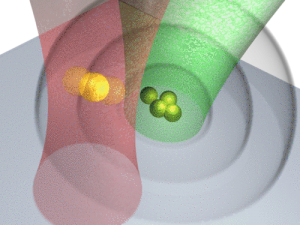For anyone who visualizes atoms as planets (many of us were taught to think of atoms and their electrons in that way) then, the planet-satellite model for nanoparticles proposed by scientists at the Nanosystems Initiative Munich (NIM) will have a comforting familiarity, Here’s the model as per a Dec. 13, 2013 news item from Nanowerk,
Nanosystems Initiative Munich (NIM) physicists have developed a “planet-satellite model” to precisely connect and arrange nanoparticles in three-dimensional structures. Like photosystems of plants and algae, the model might in future serve to collect and convert energy.
If the scientists‘ nanoparticles were one million times larger, the laboratory would look like an arts and crafts room at Christmas time: gold, silver and colorful shiny spheres in different sizes and filaments in various lengths. For at the center of the nanoscale “planet-satellite model” there is a gold particle which is orbited by other nanoparticles made of silver, cadmium selenide or organic dyes.
A Dec. 2, 2013 NIM press release, which originated the news item, describes the proposed model in detail,
As if by magic, cleverly designed DNA strands connect the satellites with the central planet in a very precise manner. The technique behind this, called “DNA origami”, is a specialty of physics professor Tim Liedl (LMU Munich) and his team. The expertise on the optical characterization of the individual nanosystems is contributed by Professor Jochen Feldmann, Chair of Photonics and Optoelectronics at LMU and Coordinator of the Nanosystems Initiative Munich (NIM).
Large or small, near or far
A distinctive feature of the new model is the modular assembly system which allows the scientists to modify all aspects of the structure very easily and in a controlled manner: the size of the central nanoparticle, the types and sizes of the “satellites” and the distance between planet and satellite particle. It also enables the physicists to adapt and optimize their system for other purposes.
Artificial photosystem
Metals, semiconductors or fluorescent organic molecules serve as satellites. Thus, like the antenna molecules in natural photosystems, such satellite elements might in future be organized to collect light energy and transfer it to a catalytic reaction center where it is converted into another form of energy. For the time being, however, the model allows the scientists to investigate basic physical effects such as the so-called quenching process, which refers to the changing fluorescence intensity of a dye molecule as a function of the distance to the central gold nanoparticle.
“The modular assembly principle and the high yield we obtained in the production of the planet-satellite systems were the crucial factors for reliably investigating this well-known effect with the new methods,” explains Robert Schreiber, lead author of the study.
A whole new cosmos
In addition, the scientists succeeded in joining individual planet-satellite units together into larger structures, combining them as desired. This way, it might be possible to develop complex and functional three-dimensional nanosystems in future, which could be used as directed energy funnels, in Raman spectroscopy or as nanoporous materials for catalytic applications.
The physicists have supplied an image illustrating their model,
![[downloaded from http://www.nano-initiative-munich.de/index.php?eID=tx_cms_showpic&file=uploads%2Fpics%2FBasiccover_6_Zeilen_02.jpg&md5=aec790fc11262dc94b41a440fa6788baeacfac97¶meters[0]=YTo0OntzOjU6IndpZHRoIjtzOjQ6IjUwMG0iO3M6NjoiaGVpZ2h0IjtzOjM6IjUw¶meters[1]=MCI7czo3OiJib2R5VGFnIjtzOjI0OiI8Ym9keSBiZ0NvbG9yPSIjZmZmZmZmIj4i¶meters[2]=O3M6NDoid3JhcCI7czozNzoiPGEgaHJlZj0iamF2YXNjcmlwdDpjbG9zZSgpOyI%2B¶meters[3]=IHwgPC9hPiI7fQ%3D%3D] Courtesy NIM](http://www.frogheart.ca/wp-content/uploads/2013/12/NanoPlanetSatellite-300x229.jpg)
[downloaded from http://www.nano-initiative-munich.de/index.php?eID=tx_cms_showpic&file=uploads%2Fpics%2FBasiccover_6_Zeilen_02.jpg&md5=aec790fc11262dc94b41a440fa6788baeacfac97¶meters[0]=YTo0OntzOjU6IndpZHRoIjtzOjQ6IjUwMG0iO3M6NjoiaGVpZ2h0IjtzOjM6IjUw¶meters[1]=MCI7czo3OiJib2R5VGFnIjtzOjI0OiI8Ym9keSBiZ0NvbG9yPSIjZmZmZmZmIj4i¶meters[2]=O3M6NDoid3JhcCI7czozNzoiPGEgaHJlZj0iamF2YXNjcmlwdDpjbG9zZSgpOyI%2B¶meters[3]=IHwgPC9hPiI7fQ%3D%3D] Courtesy NIM
Here’s a link to and a citation for the researchers’ paper,
Hierarchical assembly of metal nanoparticles, quantum dots and organic dyes using DNA origami scaffolds by Robert Schreiber, Jaekwon Do, Eva-Maria Roller, Tao Zhang, Verena J. Schüller, Philipp C. Nickels, Jochen Feldmann, & Tim Liedl. Nature Nanotechnology (2013) doi:10.1038/nnano.2013.253 Published online 01 December 2013
It is behind a paywall but you can preview it for free via ReadCube Access.
